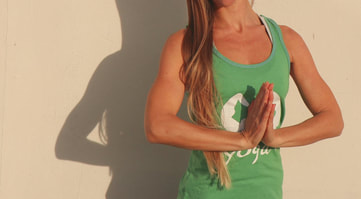|
In a previous post, I detailed how much I hated doing yoga in college and how my discovery of Alexander Technique work has transformed my relationship to the practice--in fact, it is now part of my personal morning routine. The key thing that made this change is that rather than compressing into poses and flows, I now know how to truly lengthen into them, so that yoga can be an experience of expansion rather than contraction. When your teacher asked you to 'lengthen', how do you respond? It is worth it to define some terms, as the term 'lengthening' is one that every yoga teacher uses, but can mean a variety of different things*. My experience is that most teachers actually use it to mean an engagement of the extensor muscles--essentially an arch into the back of the body (often teachers will use the term 'flat-back' the same way'. The idea is that this will 'draw you up' and open your front. The main issue with this is that this isn't how muscles work--they can't draw you up, they can only contract. So what feels like lengthening is actually a contraction of the muscles of the back that compromises the shape and integrity of the spine (especially loading the lower back and the lumbar curve, where most lower back injuries happen). Furthermore because of antagonistic action (nothing in your body works in isolation) the muscles of the front will also be activated by the increased pressure on the back,, resulting in an overall shortening in stature and compression throughout the body, especially in the joints of the lower body which will tighten to keep the body stable. This also contracts the three dimensional breathing surface, forcing the breath higher in the body (you will feel it in your sternum and upper chest).
Overall, the result is lowered mobility, relaxation, and ease (those tricky balancing poses become much harder). It also greatly increases the risk of injury--studies show that the spine can function quite well departing from a neutral stance when truly lengthened, but when compression is present movements like flexion and twists can lead to breakdown in ligaments, soft tissues, nerve irritation, and muscle strain. I think this is partially behind the phenomenon of yoga injury--though yoga done well can have wonderful rehabilitative effects on the body, done without proper form it is as dangerous as any more 'high-impact' physical activities. So how can we practice with true length? Here are a couple of ideas that can help:
If you are a yoga teacher, studio owner, or practitioner who has an interest in exploring how The Alexander Technique can help your students and personal practice, please contact me at [email protected]. *It is VERY worth noting that this blog is a generalization drawn from nearly a decade of attending group yoga classes about the instructions received most commonly from teachers--I am aware that the best teachers have a grasp of these important distinctions. However, it is a pervasive enough pattern in yoga culture that it is worth discussing. This idea of 'good posture' is intrinsic in many aspects of our society and doubly so in fitness culture. Perhaps it is an argument for smaller classes where more attention can be given to student's individual 'Use' as even great teachers can have problems conveying this idea in large groups.
0 Comments
Leave a Reply. |
Thoughts on what is going on in the work and the world right now. Many posts to come. Archives
June 2021
Categories |


 RSS Feed
RSS Feed